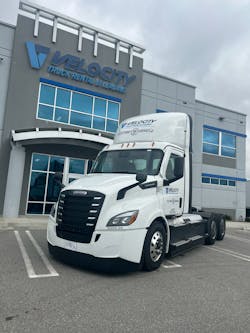Velocity Truck Leasing acquiring 200 Freightliner Electric Heavy Trucks for future Port duties
Two of the biggest ports in the world, both in California, soon will be swarming with an influx of electric drayage trucks, as the Ports of Los Angeles and Long Beach are pursuing energy transition technologies throughout their operational chains.
Looking ahead to an electrified fleet future, nearby Velocity Truck Rental & Leasing is adding 200 battery-electric trucks to its commercial rental and full-service leasing busineses.
The Velocity order is adding incoming Class 6 through 8 vehicles, including 125 Class 8 Freightliner eCascadias and 75 Class 6-7 Freightliner eM2s. The order is through producer Daimler Truck North America.
These Freightliner models can run in range up to 230 miles. Velocity’s supporting infrastructure also provide charging those vehicles in 90 minutes or less.
“Our customers are always at the forefront of what we do, and we know firsthand what it takes to put electric trucks and infrastructure in place,” said David Deon, president of Velocity Truck Rental and Leasing. “The acquisition of our new battery-powered fleet allows our customers the opportunity to go zero-emissions quickly, in addition to offering cost-saving measures through quick-charging infrastructure that is included in our leasing program.”
The entire fleet of 200 battery-electric trucks is scheduled to be in full service by 2025, with the first five Freightliner eCascadia trucks currently being deployed to Arrowlink Logistics to support pickups and deliveries at the ports of Los Angeles and Long Beach.
“Our team is excited to integrate zero-emission Freightliner eCascadia trucks into our port drayage operations so that we can reduce our impact on the local community as we transport freight between Southern California’s busy ports and local warehouses,” said Kevin Kuo, president of Arrowlink USA, Inc. “Velocity Truck Rental & Leasing has made the entire process easy for our team – including helping us determine the right truck configurations for our routes, providing training to our drivers, and supporting us in developing a plan to charge our trucks.”
Port Sides: More Coastal Decarbonization stories from EnergyTech
Port of Seattle will receive RNG from Puget Sound Energy
Port of Long Beach joins Shanghai-LA Green Shipping Corridor
Subscribe to our free, tri-weekly newsletter for Everyday Insights into the C&I Energy Transition
Velocity’s investment also includes installation of 39 dual port 150 kW chargers at multiple Southern California locations, providing customers with an affordable, reliable, and immediate option to charge battery-electric trucks. The high-powered technology allows the Freightliner eM2 to reach an 80% state of charge in approximately 60 minutes for the Class 6 model and 90 minutes for the Class 7 model. Similarly, the Class 8 Freightliner eCascadia can achieve an 80% state of charge in approximately 90 minutes utilizing dual port charging.
The ports of Los Angeles and Long Beach both have joined the Shanghai-Los Angeles Green Shipping Corridor, which is partnership of major trade cities, shipping companies, ports and cargo owners aiming form a zero-emissions trans-Pacific trade route.
About the Author
EnergyTech Staff
Rod Walton is senior editor for EnergyTech.com. He has spent 17 years covering the energy industry as a newspaper and trade journalist.
Walton formerly was energy writer and business editor at the Tulsa World. Later, he spent six years covering the electricity power sector for Pennwell and Clarion Events. He joined Endeavor and EnergyTech in November 2021.
He can be reached at [email protected].
EnergyTech is focused on the mission critical and large-scale energy users and their sustainability and resiliency goals. These include the commercial and industrial sectors, as well as the military, universities, data centers and microgrids.
Many large-scale energy users such as Fortune 500 companies, and mission-critical users such as military bases, universities, healthcare facilities, public safety and data centers, shifting their energy priorities to reach net-zero carbon goals within the coming decades. These include plans for renewable energy power purchase agreements, but also on-site resiliency projects such as microgrids, combined heat and power, rooftop solar, energy storage, digitalization and building efficiency upgrades.
